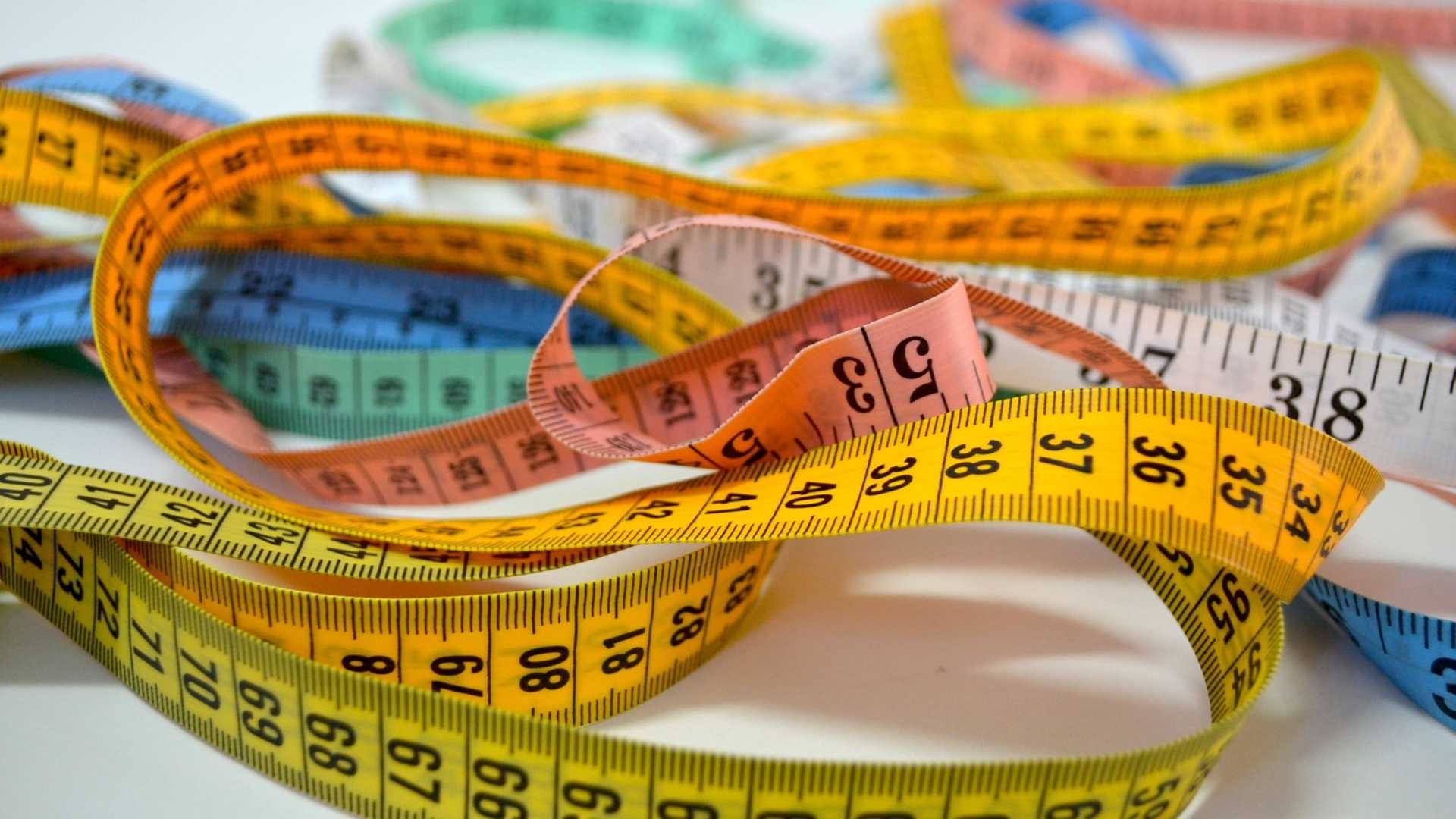How to Measure Body Fat Percentage

Photo by: Patricia Serna
Many people who set out to lose a significant amount of weight go about the process all wrong.
They slash calories, deprive themselves of food they enjoy, stress about exercise, and fall off the wagon before establishing any momentum.
We struggled for over a decade before finding a clear path toward a healthier lifestyle through calorie planning.
Let’s save you some time!
Today, you will learn how to measure your body fat percentage.
This is a crucial first step in planning how many calories you should eat daily. So let’s get to it!
Why should you care about body fat percentage?
Figuring out your body fat percentage is the best first step when starting your fat loss journey.
Some say you need to set goals first, just eat smaller portions, or simply stick with whole foods and listen to your body.
None of those ideas are bad advice. You'll probably do all those things as you transition to a healthier lifestyle.
There are many ways to begin succeeding. But we want to give you something definitive and data-driven that you can attack immediately.
Body fat percentage is the number one indicator of your overall health and fitness.
It also gives you the most solid foundation to build a personalized calorie plan. So that’s where we’ll begin.
Can I just track my weight with a scale?
Maybe the thought of measuring your body fat sounds uncomfortable.
After all, getting on a scale is enough to induce anxiety in most overweight people - and now we’re talking about measuring body fat.
Perhaps you’re wondering if you can just track pounds using a scale or use a Body Mass Index (BMI) chart as a progress indicator.
You will need to weigh yourself on a scale to find your body fat percentage.
You can gather additional data points like BMI if you’d like, although it’s unnecessary.
But you can’t ignore body fat percentage.
The reason is simple.
Scale weight does not distinguish between pounds from fat and pounds from muscle.
Neither does BMI. BMI only compares the amount of weight you carry to your height.
Why is the distinction between pounds from fat vs. muscle important?
Because you want to keep every pound of muscle you have. You only want to lose fat.
Let’s look at a quick example:
Scenario 1
You step on the scale and see that you are down five pounds. Great! …or is it?
What if four out of those five pounds is due to muscle loss and only one pound is from losing fat?
Scenario 2
You check your scale weight. It’s three pounds less. However, this time - the entire three pounds is fat loss.
Results
| Scenario | Total Weight | Fat Loss | Muscle Loss |
|---|---|---|---|
| 1 | -5 lbs. | -1 lb. | -4 lbs. |
| 2 | -3 lbs. | -3 lbs. | 0 lbs. |
Which scenario do you prefer?
I’ll take Scenario 2 every week! Lose the fat. Keep the muscle!
To distinguish between fat loss and muscle loss? You need to measure your body fat.
Scale weight alone doesn’t tell you the amount of fat on your body.
Measuring your body fat percentage does!
What are the benefits of calculating your body fat percentage?
Body fat percentage is the most critical metric in your weight loss journey.
You gain several benefits just by knowing a little bit about your body.
1. Your body fat percentage establishes a starting point.
When you want to lose a lot of weight, the hardest part is getting started on a clear path.
The best way to lose fat is to consume fewer calories than you burn. In other words, you must create a calorie deficit.
The best way to maintain a consistent calorie deficit is to plan how many calories you should eat daily.
The best way to plan your calorie intake is to track your body fat percentage.
Knowing your body fat percentage gives you the complete picture of your body composition as it is right now.
Once you know where you are starting, you can see where you’re going.
You’ll be able to determine how many calories you should be eating. Plus, you’ll have a single metric to track to see if your actions are working.
2. Your body fat percentage allows you to calculate your calorie requirements.
When you know your body fat percentage, it’s practically effortless to figure out how many calories you need to eat daily.
Most people have no idea how many calories they should consume daily. That's pretty common.
Many fad diets and programs are designed to get quick results through carb slashing. But most of these methods are unsustainable over the long term.
With a few quick calculations, you’ll have the most accurate estimate of how many calories your body needs.
And let’s be honest, the goal is not to stay in a calorie deficit forever. That would suck!
You will eventually be at a weight that you want to maintain. Or you’ll decide you want to put on some extra muscle using a calorie surplus.
So as your goals change, knowing your body fat percentage will allow you to adjust your calorie requirements to match. You'll become comfortable adjusting your calorie intake for a cutting phase, maintenance mode, or building muscle.
Knowing how to adjust your calorie requirements based on your body composition and goals is highly liberating. You will save so much time, guesswork, and stress!
3. Your body fat percentage provides easy progress tracking.
Having a goal to shoot for is very important with anything you accomplish.
When you need to lose a lot of weight, we recommend setting two types of goals.
Your first goal should be quantitative.
That means the goal is numbers-based and measurable.
When you know your body fat percentage, your quantitative goal is set for you without any work.
The goal is to reduce your body fat percentage at a healthy pace.
Losing 0.5% - 1.0% of body fat per week is reasonable. Some weeks could be more or less.
If your results aren’t going in the right direction after 2-3 weeks, you probably need to adjust your calorie plan.
Your second goal should be qualitative.
That means the goal is based on your own personal interpretation.
It’s a goal that isn’t necessarily measurable.
This goal should relate to the quality of your personal life - something only you can determine.
Examples might include:
- your energy level
- how strong you feel
- anxiety reduction
- how you look in the mirror
- your sex life
- how your clothes fit
What are some methods for calculating body fat percentage?
Let's review a few methods for measuring body fat and then finish the list with our top choice.
Skin Fold Measurement
This is a common method performed using a set of calipers.
Depending on the method, skin fold measurements are taken on several body areas or as little as one site just above the hip bone.
You grab a layer of fat and use calipers to take a measurement.
The measurements are compared against a chart based on gender and age to derive your body fat percentage.
This method isn’t very doable when you have a lot of fat around your stomach and hip area. If you need to lose as much weight as we did, the calipers might not fit around the fat.
Calipers are the method most prone to human error. But as you reduce your body fat, it can become a relatively quick and easy way to track.
Some facilities will perform the skin fold measurements for a fee.
We prefer something that can be done in the privacy of our own home every week.
Bioelectrical Impedance Analysis (BIA)
BIA is another common method used at home with special scales and at gyms with unique equipment.
This method involves sending a low-current electrical signal through your body and measuring how much resistance is received to determine your body fat percentage.
Not suitable for pregnant women or folks with a pacemaker!
The accuracy can also vary greatly depending on hydration levels and how many electrolytes you have in your body. In our opinion, it’s not worth it.
Dual-energy X-ray Absorptiometry (DXA or DEXA)
Are you kidding me? X-rays are dangerous and expensive. Next.
Hydrostatic Weighing
This method is not readily available to most people.
It’s somewhat complicated and expensive, which is not ideal when all you need is an effective way to track fat loss.
With this method, you are weighed on land and then slowly dunked into a water tank while sitting on a scale.
The weight on-land and dunked are run through some formulas to determine your body composition.
The hydrostatic method is considered by many to be the most accurate.
However, while underwater, you have to force all of the air out of your lungs, or else its accuracy suffers.
It’s also definitely not something you’ll do weekly in your bathroom!
Air Displacement Plethysmography (ADP)
This method is like the dry version of Hydrostatic Weighing.
You hop into a little chamber that looks like an escape pod on a spaceship.
Your body volume is measured via chamber pressure before and after you enter the pod.
Then your body mass and volume are used to calculate body density.
Again, hydration levels and body temperature can distort the results.
We can’t see the point of having one of these pods at a gym where body temperature and hydration levels would definitely be elevated!
But some do, so there you go.
What is the best method for measuring body fat percentage?
The U.S. Navy Circumference Method
The U.S. Navy Circumference Method is our favorite for measuring body fat percentage.
We think it's the best because it’s simple, affordable, and consistent.
With the U.S. Navy method, you take a few measurements with a soft tape measure and plug some basic stats into a calculator.
That’s it! You'll have your body fat percentage in 5 - 10 minutes.
Like any other method, human error can cause some accuracy issues. In other words, you have to measure consistently.
It may feel a bit awkward the first time. But this process is simple!
You’re just looking for a reasonably accurate measurement that you can perform each week that lets you know you’re going in the right direction.
Consistency matters more than precision.
Okay, we have a winner. Now what?
What will you need to measure for calculating body fat percentage?
Here are the stats you need to collect.
Don’t guess on any of these. Break out a scale and a soft tape measure to get the job done correctly.
We also recommend taking these measurements the same day every week.
You'll want to measure in the morning - after you use the bathroom but before you do anything else like showering, eating breakfast, or working out. Here we go!
Weight
This one is easy but can seem difficult mentally for some folks.
But getting on a scale doesn’t need to be a negative thing. Remember, you're just gathering facts and using them to your advantage.
Invest in an appropriate scale for your size and hop on.
If you need one, here is a digital scale with a 550-pound capacity for under $50.
Height
When measuring your height, stand up straight with your shoulders back and look straight forward.
Don’t slouch. Standing with your back against a wall can help.
It’s probably easiest to have a friend or family member assist.
If that’s not an option, no problem. You can step on a tape measure and get a pretty accurate reading yourself.
Or you could tape a piece of paper to the wall close to your height, put a ruler on top of your head, mark the paper with a pencil, and then measure the distance from the floor.
You don’t need to take this measurement every week since your height will not change much.
Waist
Sometimes the waist and hip measurements can be confusing because of varying body types and the amount of fat around your mid-section.
We recommend measuring above the belly button, just below the rib cage.
For men, you'll measure around the navel or just above.
For women, you'll measure at the narrowest point of your waist.
If you're not sure where to measure, a trick you can use is to bend to one side to find the natural crease of your waist. Wrap a soft tape measure around this point.
Make sure the measuring tape is even around your body - parallel to the floor with no kinks or twists.
You want the tape measure to be snug but not too tight.
Hip (women only)
Men and women need to take a waist measurement, but only women need to capture a hip measurement.
Stand with your heels together and wrap the soft tape measure around the fullest part of your hips and butt.
Make sure the soft tape measure is parallel to the floor.
Standing in front of a mirror or having a partner help you out can make taking this measurement a bit easier.
Neck
Stand up straight with your shoulders back and look straight forward.
Don’t overextend your neck in any direction.
Measure at the narrowest point of your neck - below the larynx, with the tape sloping downward to the front.
If you’re unsure where that is, measure in the middle of your neck - between your chin and collar bone.
Shoot for the same spot each week. You will get a feel for it after a few times.
Your neck measurement will decrease the slowest compared to your waist and hips.
But unlike your height, it’s worth checking each week.
Measurement Tips
Here are some helpful tips for measuring your body consistently:
- Stand up straight with your shoulders back, head up, and look straight ahead.
- It never hurts to measure multiple times. You can take the average or the largest measurement.
- It's okay to round to the nearest half or quarter inch. Consistency is more important than precision.
- Don’t hold your breath, suck in your tummy, or purposefully push it out.
- Stand relaxed and natural. Then breathe out normally and check your measurement after you exhale.
- Don’t pull the measuring tape too tight or too loose.
- We recommend measuring naked or wearing underwear. If you would rather stay clothed, wear thin clothing that fits snugly but not tight.
- Measure on the same day each week.
- Measure in the morning after you use the bathroom and before doing anything else.
Which calculator should you use for calculating body fat percentage?
Many body fat percentage calculators are available online, but some are better than others.
You can even use a spreadsheet to make your own if you want. Although, we like to keep things as simple as possible.
We prefer this body fat calculator.
It provides a friendly, clean interface and allows you to enter decimals, which is nice when you want to claim every half-inch of progress!
You can enter Imperial or Metric units for your measurements.
It also gives you some realistic targets to shoot for based on your age.
Evaluating Your Results
Your measurements and body fat percentage calculations are meant to help guide you. They will fluctuate over time.
You may lose 1% body fat one week, then nothing the next, lose 2%, gain 0.5%, then lose 1%, and so on.
Do not overreact to your measurements.
If you get frustrated and make large dramatic changes, you'll find it challenging to stay on track.
Instead, make minor adjustments to your nutrition and exercise habits and work to get the desired results.
Be patient, realistic, and optimistic!
As we go, we will dive further into the mental side of fat loss. However, the best way to stay on track is simply to be kind to yourself.
Remember why you decided to set out on this journey in the first place.
If your mind generates negative thoughts and emotions - just think about what you'd say to a friend or loved one if they were saying what you're thinking.
Be there for yourself like you'd be there for them.
Don't beat yourself up - build yourself up!
Final Thoughts
Tracking your body fat percentage is the best way to know that you are progressing toward your fat loss goals.
Although there are some unorthodox methods available for measuring body fat, the best strategy is to stick with something simple that works.
The U.S. Navy Method is our favorite because it's simple, cheap, and effective.
It’s easy to track your weekly results in a notebook or a spreadsheet.
Set a weekly reminder to take your measurements and hold yourself accountable to stay on schedule.
Never get down on yourself if you feel like your results don’t reflect the work you’re putting in.
Losing fat is not a linear process. Some weeks will produce better results than others. You'll zig-zag your way to success.
- Remember why transforming your body is important to you.
- Be patient with yourself regardless of your progress each week.
- Be honest about small changes you can make to improve your results.
- Stay positively focused as you march toward a healthier, happier you.
There is no better time to take control of your destiny than right now!
You can do this! We’re here to help!
Until next time, take care.

